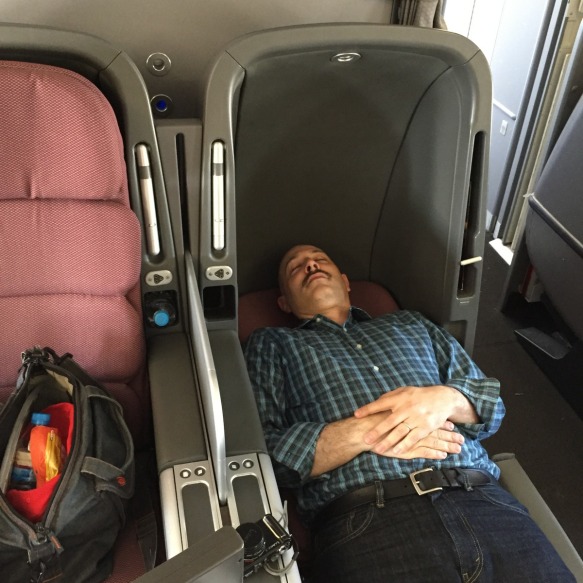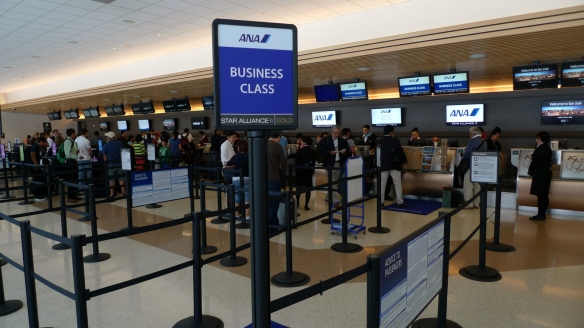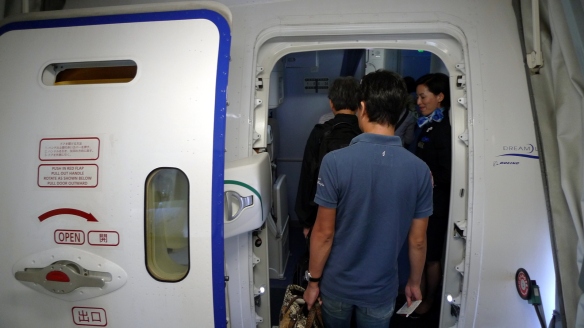In June, I wrote a post detailing how I decided to fly business class home to the US in July. In this post, I will follow up and share how the experience was – and how I feel about the decision. Hopefully, I will also create a video or two for my YouTube channel. But in the meantime, here’s a start:
My flight departed Bangkok at 7:00 am. I arrived about 5:15 am, giving myself a bit more time than I might otherwise have needed because there is paperwork you need to provide before flying, like a COVID-19 PCR test. The check-in turned out to be quite smooth and security and immigration were, too, because nobody is flying.
The shops were mostly closed and many were boarded up. Those that were open had forelorn employees standing around, looking bored. I walked the long and gloomy concourse to the only THAI Airways lounge that was open, a small, recently rennovated one on concourse E. There were only two other people in the lounge. Food options were limited and all pre-packaged.
About boarding time, I proceeded to gate F5 where I found my ride, an All-Nippon Airways Boeing 787-9 Dreamliner in Star Alliance livery. There were perhaps 40 passengers on this 246-seat aircraft, so boarding was quick. To help minimize passenger contact, ANA has changed their boarding zone so, regardless of your status or the cabin you are traveling in, they board from the back of the plane to the front.
All-Nippon is a Japanese airline and their onboard experience is distinctly Japanese. The safety video features characters in Kabuki makeup and costumes and is interlaced with illustrations done in the style of traditional airline safety cards but with Japanese characters. Here is the illustration for the importance of not wearing high-heel shoes (or okobo!) when evacuating the aircraft. You might tear the slide. These touches make the experience really special – you feel like you’ve arrived in Japan even before you have left.
We had an on-time departure from runway 1L, heading south over the rice paddies and factories of Samut Prakan province and then turning north towards Hong Kong as we climbed into the cloudy morning skies. I always enjoy flying, but flying early in the morning fills me with a feeling of possibility, like I am embarking on a grand adventure.
I was traveling in ANA’s staggered business class that is technically “old”, because ANA has launched a new product called “The Room” that is even snazzier. This business class that you see was introduced in early 2010. While it is more than a decade old, it really is still a very comfortable and private way to fly. There are two critiques of the layout:
- First, they seats are very cubicle-like. A lot of people who fly business class like this layout because it gives you a lot of privacy. And, certainly, during this pandemic it is preferntial to be in a layout that shields you from others. But this layout looks quite boxy and doesn’t quite appeal to me.
- Second, there are no adjacent seats. Often, the center seats on some business classes will alternate with two seats close together and, in the next row, two seats far apart. These adjacent seats are great when traveling with someone else. ANA didn’t design their old business class for that. However, the new arrangement will feature this.
Overall, the seat was very comfortable. It offered good storage, reclined into a comfortable relaxation position, and when laying fully flat it made for a comfortable bed. The footwell, in particular, is large enough in all seats that you can sleep on your side and still have room for your feet. The bed comes with a mattress cover, duvet, and a substantial pillow. I was able to sleep well and on my 12-hour return from Chicago to Tokyo, slept eight hours.
The above picture is on the Boeing 777-300er I flew returning from Chicago to Tokyo. It had a few small differences from the 787-9 I was on from Bangkok to Tokyo and return, but you would be hard-pressed to notice them. The tray table mechanism is larger and extends from underneath the monitor in the 777 instead of swinging out from underneath the console next to you. Also, the 777 has a small storage box on the wall to the side of your seat. The seats and comfort were quite similar, though, and the service was the same.
You can also see how lightly loaded the cabin was. On my flight from Bangkok to Tokyo, I was the only person in a 12-person cabin.
ANA has a good reputation for catering. Since it was a morning flight, I opted for the western meal instead of the Japanese option. This may seem foolish, since Japanese food should be the obvious choice! But I saved my Japanese food for my flight out of Tokyo, figuring it would be better there. The food was generous in portion size and tasty enough, although nothing outstanding. With the pandemic, instead of serving food from carts or bringing individual dishses and laying them out on the tablecloth, all your food is served on one tray and plastic or foil covers are on every dish.
The flight to Tokyo lasted about five hours. I slept about two hours on the flight, looked out the window, and watched some Netflix on my iPad. The in-flight entertainment system has a large screen and is responsive. The selection of shows is okay but not as extensive as on some airlines. Since I brought my own device, I just used it instead. We landed in Tokyo Narita Airport about 3:00 pm. Above, a view of the Boeing 787-9 I flew from Bangkok, seen parked at Tokyo Narita Airport. This is really an elegant and comfortable plane!
The conclusion about ANA on this first flight, was that the seats were very comfortable, the food was decent, and the service was spectacular. The flight attendants were friendly, attentive, and organized. They knew from the itinerary that I was continuing on to San Francisco, so they packed me a special goodie bag with lots of ammenity items, some souvenir ANA postcards, and two special items shown in the picture above.
The first was a hand-written note that was personalized, talked about a festival that was going on, and referenced my trip to San Francisco. This was such a great touch. Japan has a culture of aviation enthusiasts, so they also included a postcard (on the right) which provided information about the flight such as plane number, plane type, flight level, etc. Again, these are details that go above and beyond the basic expectations and leave me feeling like ANA is a great way to fly.
I had a two-hour layover between flights. Narita was not very busy. Many shops were closed and it was just a shadow of what I usually see when transiting there. I decided to go to the lounge. ANA usually has three lounges in Narita and United Airlines has one. During the pandemic, only one ANA lounge was open and, in fact, they used only the First Class side of their lounge.
The lounge was fairly crowded and attendants were circulating like sharks, checking for mask use when people were not eating or drinking, picking up trays and used dishes, and keeping things in good order. All the foods were pre-packaged but the hot food bar, where you can order noodles or rice and curry, was open. I enjoyed a nice bowl of soba noodles with pork katsu and a glass of draft beer. The views of the tarmac are spectacular and the skies were blue and the grass verdant green. I could have spent all day watching the planes.
All too soon, I had to walk to sattelite four, where United operates its flights. In normal times, they have at least one daily flight to Newark, Washington D.C., Houston, Chicago, San Francisco, Los Angeles, Honolulu, and Guam – and usually two flights to some of the cities. This day, it was down to three flights: Guam, Los Angeles, and my flight to San Francisco. Today’s flight was operated by a Boeing 787-9 Dreamliner. Behind my San Francisco flight was the one of Los Angeles, which left about 30 minutes earlier.
I chose this flight specifically because I wanted to try United’s Polaris business class. United introduced Polaris in 2016 but to this date, some of their long-haul fleet still has not been reconfigured. Specifcially, that Los Angeles flight, which I was rebooked on by United, uses an older 2-2-2 configuration which means if you sit at a window seat, you do not have direct aisle access. You will note that the overall look and feel is similar to ANA’s business class and the blue color scheme is similar. One advantage is that alternating rows of middle seats are placed closer together, perfect for couples.
The seats themselves are thoughtfully designed and similar in space and comfort to the older ANA seats. The Saks Fifth Avenue bedding that you see in the above photo had been modified a bit for my flight. The lightweight blanket was gone, but there were still two sizes of pillos and a duvet. The pajama service, which ostentisbly is available on longer flights, was not available on mine – but that may be because it is only a nine-hour flight.
The seats recline to fully flat and are comfortable. I did find the shoulder space to be a bit narrower than on ANA and I would sometimes run into the long armrest that stretches below the windows. The foot wells can be a narrow in some rows. The bulkhead seats, of which I chose one, have more space and were sufficiently large. I was able to sleep about five hours on the almost nine-hour flight.
Inflight service was not as good as on ANA. There were three flight attendants serving business class, which was about one-quarter full. One of them was brusque and not at all welcoming. The other two were a bit friendlier but just seemed disorganized and forgetful. I had to repeat requests for things and after ordering, one flight attendant told me I couldn’t have my first choice for entree while the other then brought me by first choice. But when I asked about the red wines, one flight attendant brought all three bottles so I could see them, which was a nice touch.
In terms of food, United’s catering is such a disappointment. For dinner, I chose what was ostensibly a filet of beef. It was such a sad, beige looking thing. And the baked side dish, some sort of a truffle-flavored polenta or something, was crusty and forgettable. The roasted beets were nice, because I love beets. The salad was limp and the dessert was some sort of a prepackaged brownie. Just underwhelming. Like ANA, everything was served on a single tray and all the items had plastic or foil covers.

For breakfast, I chose the Japanese option, figuring we had departed Japan so this might be okay. The dish was a tiny piece of mackerel served with the saddest steamed vegetables and a gloppy, sweet sauce. And the muffin, which I hope was meant to be green tea flavored, was this unappetizing greenish color.
The one thing I appreciate is that they didn’t serve breakfast until about an hour before landing. Many airlines will start their pre-landing meal in business class 90-120 minutes before landing, which interrupts your sleep. Especially because they were serving everything on a single tray, dinner was done early and breakfast could be served late, giving passengers more time to rest.
United’s entertainment system is quite a bit better than ANA’s, though. The screen is brighter and easier to see and the selection of entertainment is extensive. If you need to be distracted (which you will be because of the food!), United does that well.
The flight was smooth and not long after breakfast, we broke through the coastal fog to land in San Francisco. We parked at the international terminal and I was the first person to the baggage claim belt, which was completely desserted. Thankfully, the baggage arrived quickly and my bags were among the first off. If you are curious, immigration was very quick and nobody inquired at all about COVID, although I had shown my COVID test results when checking in at Bangkok and again at the gate in Tokyo.
The international flights both had few passengers and a lot of personal room. This changed for the domestic flights, where both my flight to Denver and the onward flight to Kansas City were completely full. Thankfully, I was in business class for these flights, too, so at least wasn’t completely squeezed in.
The domestic flights were both delayed, the first one by almost an hour with no clear explanation given. And when we landed in Denver, we waited another 15 minutes for our gate to free up, which was especially frustrating as many passengers had very tight connections. I did make it to Kansas City only about 45 minutes late, though, and my parents picked me up shortly after.

So, the question is, was it worth it to fly business class? The two international flights had a premium economy cabin, so I could have saved some money and had seats equivalent to domestic first class. Overall, having more room and more cubicle-like space during this pandemic, made me feel safer. And being able to sleep on the flights seemed to help with my jet lag: I really did not suffer any considerable jet lag on this trip. I would not have slept much, or very well, in premium economy or regular economy.
What I don’t think was worth it, was flying with United. I’m a former United employee and really want the company to succeed, but I was disappointed with the experience – especially domestically. I overheard three of the flight attendant for my San Francisco to Denver flight discussing that this was their first flight back from furlough. On none of my United flights, did I encounter any employees (on the ground or in the air) that really convinced me they genuinely appreciated my business. Compare this to ANA, where I was treated as a unique person, and I think I would try to avoid United as best I can in the future.

















































 With only 35 of these seats in this mini cabin, this would be my choice to enjoy some comfort on a long flight without breaking the bank.
With only 35 of these seats in this mini cabin, this would be my choice to enjoy some comfort on a long flight without breaking the bank. Ahead of the Premium Economy cabin are two Business Class cabins, seating a total of 64 passengers. The seats are arranged in pairs, six-abreast. This layout, which has been in place since the introduction of the A380s, will soon be replaced with a new layout which allows each passenger direct access to the aisles. Truthfully, though, I prefer this type of pair seating as it feels less confined to me and is a better arrangement when traveling with another person. Even which the seats are reclined, it is not difficult to get to the aisle.
Ahead of the Premium Economy cabin are two Business Class cabins, seating a total of 64 passengers. The seats are arranged in pairs, six-abreast. This layout, which has been in place since the introduction of the A380s, will soon be replaced with a new layout which allows each passenger direct access to the aisles. Truthfully, though, I prefer this type of pair seating as it feels less confined to me and is a better arrangement when traveling with another person. Even which the seats are reclined, it is not difficult to get to the aisle.











 The view looking forward to the nose wheel. In the distance, a Qantas Boeing 747-40 sits in the hangar, undergoing maintenance.
The view looking forward to the nose wheel. In the distance, a Qantas Boeing 747-40 sits in the hangar, undergoing maintenance.























































































































